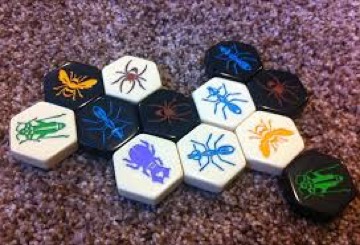The month of April is Chess Jam, an indie game jam organized by game maker Sophie Houlden. The rules for the jam are simple, to make a game or work inspired by the game of Chess. Chess is believed to have been invented in the 6th century in India and spread worldwide over several centuries. The present standard chess piece configuration and rules for moving are believed to have been developed in 15th century Spain, standardized in the 1800s.
I am a huge fan of chess and have read a number of strategy books but I realized I didn’t want to dedicate so much time to perfecting my game. My joy lay in the beauty of the gameplay. I took a step back and started getting more absorbed by chess variants and games inspired by chess. While a MFA candidate at UCLA, I took a class in game design and built a chess variant called Chezz++, influenced by the game Bosworth a 4-player chess variant by Funagain games, as well as Knightmare Chess, a deckbuilding game that uses a pack of cards to alter pieces or the rules of a game almost like a combination of Chess and Magic The Gathering.
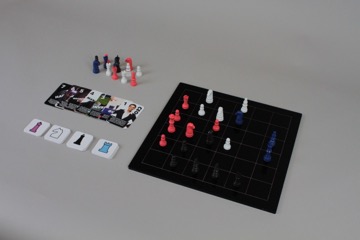
At UCLA I also co-curated the Game Arts Festival at The Hammer Museum in 2015, a festival that included performances, board games, videogames and machinema. One of the projects we featured was Nova Jiang’s Orthogonal Diagonal, which presents 8 different chess variants from around the world with special 3d printed pieces and lasercut boards that indicate how to use the pieces through their design. In addition to the long history of Chess as an analog board game there is an exciting history of computer chess. The initial idea of a chess-playing automaton can be traced to the 1770s with the Mechanical Turk, a hoax that actually concealed a tiny chess grandmaster inside its cabinet secretly moving the pieces with levers. In my 2016 work Literal Mechanical Turk I created a contemporary version of the hoax. I posted tasks to Amazon’s Mechanical Turk, submitting chess moves in Algebraic Notation as if I was testing a computer chess program, though I asked Turkers to film themselves making response moves (note: I paid significantly higher than most tasks posted to Mechanical Turk). Together, we played a complete game of chess, with my own role as player concealed. I won the game.

In the first half of the 20th century a number of ideas for chess-playing algorithms were proposed, and the first prototype machine to play a simplified game was created by Leonardo Torres y Quevedo in 1912. None other than Alan Turing was the first to propose a full system for a chess-playing program capable of playing a full game. Martin Gardner’s article on Mathematical Games appeared in Scientific American in 1962. In it he describes Hexapawn, a chess-like game played with black and white pawns on a 3x3 grid board. He talks about how computers may one day be taught to play chess, and a simplified system for building your own analog machine intelligence to create a program that teaches itself to improve its game. I read this article as a child in the 80s and it was deeply influential to me. I built my own version of Hexapawn as described in the article using matchbooks to store the logic. Later I came across a BASIC Hexapawn program in the 1978 BASIC Computer Games book. It is a classic university computer science assignment to build your own Hexapawn program from scratch, often in C, C++ or Java.
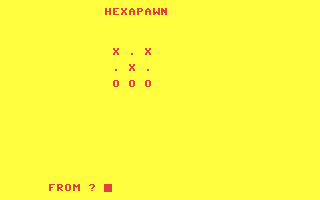
So many people find inspiration in Chess, which I think comes down to the beauty, simplicity and idiosyncracies of the game. You can start quite small, learning the rules, but there is always more to perfect. The term chess variant was defined by David Pritchard in his book The Encyclopedia of Chess Variants simply as “related to, derived from, or inspired by chess.” The book was published in 1994 and contains 1400 variations on the traditional chess game. Chess variants tend to expand on the rules primarily through creating new chess pieces, known as Fairy pieces, expanding the number of players, changing something about the board, or changing the win objective from Checkmating the opponent’s king to another win-state.
With so many variants it can be hard to know which direction to turn to find a game that excites you, or in the case of the chess jam, to know which direction one should explore when creating their own chess-inspired game. Below I have compiled a number of interesting chess variants or games inspired by chess including board and video games. Rather than an attempt at breadth, this is an extremely selective list of games that I think are particularly unique or exciting. In general, areas relating to storytelling or new conceptual approaches, perhaps married to creating new pieces appears underexplored in the world of chess variants and chess-inspired games. As a child I that included a playable story of an adventurer that squares off with a number of enemies and chess challenges, a quest-based approach to chess that I think could be rather exciting.
Below, I list some of my favorite chess variants and inspirations. In addition I highly recommend reading the List Of Chess Variants Wikipedia page, which lists an incredible number of variants broken down into various categories. In fact, I was surprised to find that there are 1-dimensional chess variants, an area that seems worth exploring further (I am also thinking about the 1-dimensional roguelike/dungeon-crawler games Line Wobbler and Cosmic Crown, 2 games that are simple but compelling.
If you are interested in creating your own variant, you may also want to read Chess Variants Are Easy which lays out various concepts for the creation of different chess variants by the author.
And without further ado, here is a list of inspiring, exciting or confounding new chess variants and inspirations…
Play It By Trust
Play It By Trust aka White Chess Set (1966) is by Yoko Ono. In the game, both sides play with white chess pieces, continuing the game until the players have lost track of who owns which pieces. The game has been positioned as a peaceful game, as opposed to the metaphor of war suggested by traditional chess rules.
“Many artists have worked with chess, but they usually worked with the decorative aspect of the chess pieces. I wanted to create a new chess game, making a fundamental rather than decorative change. The white chess set is a sort of life situation. Life is not all black and white, you don’t know what is yours and what is theirs. You have to convince people what is yours. In the chess situation it is simple if you are black then black is yours. But this is like a life situation, where you have to play it by convincing each other.”

Interestingly, Ono also created the iOS chess game Yoko Chess in 2015, which includes a normal version of chess playable with dog pieces, as well as Play it by Trust. Sadly, it appears this app has disappeared from the app store.

Orthogonal Diagonal
Orthogonal Diagonal by Nova Jiang.
8 international versions of Chess, with pieces and board designed to make gameplay easy to learn. This isn’t a variation or variant of chess so much as a meta presentation and design to present variants. Through standardizing the presentation of the boards Jiang presents these chess variations as unique iterations of the same ancient system. The chess variations presented areThai, Mongolian, Burmese, Japanese, Korean, Chinese, western Chess and ancient Persian.
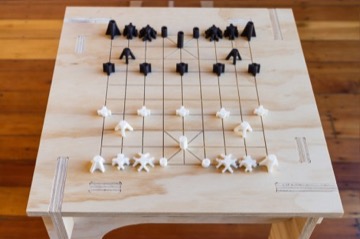
Knightmare Chess
Knightmare Chess published by Steve Jackson Games, or its older french cousin Tempête sur l’échiquier (Storm on the Chessboard), designed by Pierre Cléquin and Bruno Faidutti. In Knightmare Chess the players build decks, draw and play cards that change the default rules of chess. Cards affect individual pieces on the board, change game objectives, create special spaces on the board, or have other effects on the game. In my experience Chess purists hate this variation as each turn dramatically changes the meta-rules of the game, making any longterm strategy relatively useless.

Bosworth
Bosworth is a 2-4 player chess variant played on a smaller 6x6 grid, along with playing cards. There is no checkmate in the game. Players attempt to capture all enemies’ kings to win. Each player has a deck of cards listing all of their pieces. They must play a card in order to cast one of their pieces on the game board.
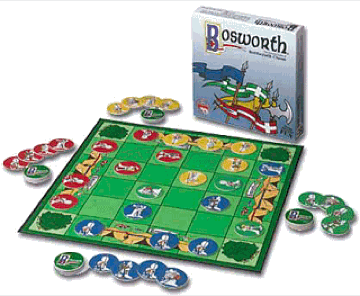
Chesh
Chesh is an iOS game by Damion Sommer. It presents a randomly-generated board game for two played between 2 human players or a single player versus the computer. Unlike Chess, which rewards digging in deep and mastering the moves of the game, Chesh is designed to be unpredictable. Each game the pieces’ moves are randomly generated. You find out how they can move when you select a piece and its possible placement is revealed. In this way, learning the opening moves of the game is impossible. There is no checkmating in the game. You win by taking a certain value of your opponent’s pieces. Interestingly, I discovered an earlier version of Chesh called XYQ4 posted online here, linked from this article in KillScreen (RIP).
Proteus
Proteus is created by Steve Jackson Games, who produce Knightmare Chess. Proteus is a dice-game with chess-like pieces. The game is out of print but a printable chessboard and ruleset is available online.
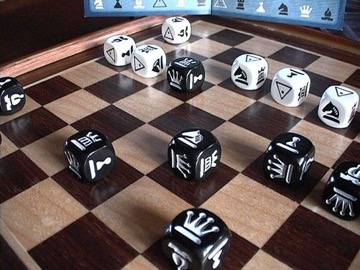
Hive
Hive by Gen42 games has been described as the next chess by The Wall Street Journal. In this tile-based chess-inspired game, pieces are added to the playing area as you go, which also creates the board. Hive is a good example of a game inspired by Chess but with different pieces, board and gameplay.
